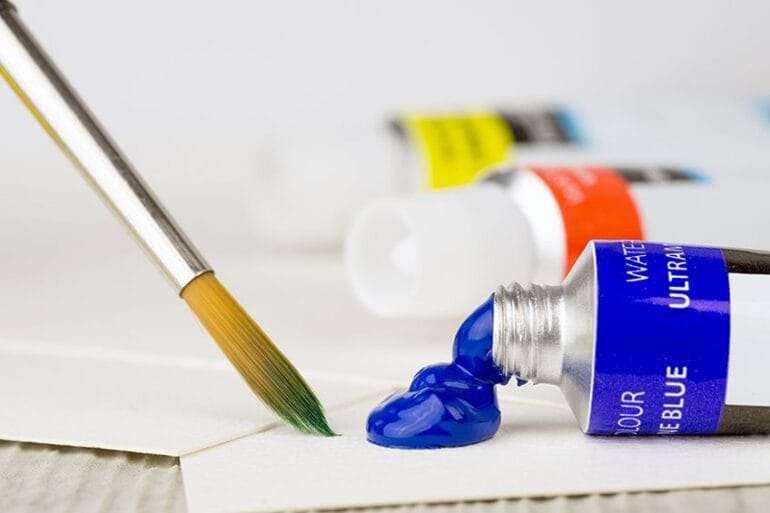If you’ve recently painted your concrete surface with acrylic paint, you’ll want to ensure its longevity by sealing it properly. Sealing acrylic paint on concrete is crucial to protect it from weathering, UV damage, and general wear and tear. By applying a sealant, you can enhance the vibrancy and durability of your painted surface, making it last for years.
When it comes to sealing acrylic paint on concrete, there are several options available. One popular choice is using a clear acrylic sealer, which creates a protective barrier over the paint while allowing it to maintain its glossy finish.
Before applying the sealer, it’s important to prepare the surface by cleaning it thoroughly to remove any dirt, dust, or debris. You can use a mild detergent and water solution or a concrete cleaner specifically designed for this purpose. Once the surface is clean and dry, you can proceed with the sealing process.
Start by selecting a high-quality clear acrylic sealer suitable for outdoor use and compatible with acrylic paint. It’s recommended to choose a sealer with UV protection to prevent fading caused by sunlight exposure. Apply the sealer using a brush or roller in thin, even coats, ensuring complete coverage.
Allow the sealer to dry according to the manufacturer’s instructions, which usually takes a few hours. It’s essential to apply multiple coats of the sealer for better protection and durability. Between each coat, lightly sand the surface to

Step-by-Step Guide on Sealing Acrylic Paint on Concrete
If you have recently painted a concrete surface with acrylic paint and want to ensure its longevity and durability, it is essential to seal the paint. Sealing acrylic paint on concrete not only protects the paint from moisture, UV rays, and stains but also enhances its appearance. In this section, we will provide a step-by-step guide on how to seal acrylic paint on concrete for long-lasting results.
Materials and Tools Needed
Before starting the sealing process, gather the following materials and tools:
- Acrylic concrete sealer
- Paint roller or brush
- Paint tray
- Clean cloth or sponge
- Mild soap or concrete cleaner
- Water
- Sandpaper or sanding block
- Dust mask
- Protective gloves
- Drop cloth or plastic sheeting
Step 1: Prepare the Surface
The first step is to prepare the concrete surface for sealing. Start by cleaning the painted area using a mild soap or concrete cleaner mixed with water. Use a clean cloth or sponge to scrub the surface gently. Rinse the area thoroughly with water and allow it to dry completely.
If there are any rough spots or imperfections on the painted surface, lightly sand them using sandpaper or a sanding block. Wipe away any dust or debris with a clean cloth.
Step 2: Choose the Right Sealer
Next, choose the appropriate acrylic concrete sealer for your project. There are two main types of sealers: solvent-based and water-based. Solvent-based sealers provide a high gloss finish and are more durable, while water-based sealers offer a matte or satin finish and are environmentally friendly.
Consider factors such as the location of the painted surface (indoor or outdoor), desired finish (glossy or matte), and level of protection required when selecting the sealer.
Step 3: Apply the Sealer
Begin by protecting the surrounding areas with a drop cloth or plastic sheeting to prevent any accidental spills or splatters. Put on a dust mask and protective gloves for added safety.
Pour the acrylic concrete sealer into a paint tray. Use a paint roller or brush to apply a thin, even coat of sealer onto the painted concrete surface. Start at one end and work your way across, applying the sealer in long, overlapping strokes. Avoid leaving puddles or thick layers of sealer.
Allow the first coat to dry according to the manufacturer’s instructions. Apply a second coat of sealer in the same manner as the first, ensuring complete coverage of the painted surface.
Step 4: Cure and Maintain the Sealed Surface
After applying the final coat of sealer, allow the surface to cure for the recommended timeframe provided by the sealer manufacturer. During this curing period, avoid any heavy or abrasive contact with the sealed surface.
To maintain the sealed surface’s longevity, clean it regularly using a mild soap and water mixture. Avoid using harsh chemicals or abrasive cleaners that can damage the sealer. Additionally, periodically inspect the sealed surface for any signs of wear or damage and apply a fresh coat of sealer if needed.
Summary
Sealing acrylic paint on concrete is a crucial step in preserving and protecting the painted surface. By following the step-by-step guide outlined above, you can ensure the longevity and durability of your acrylic paint while enhancing its appearance. Remember to prepare the surface properly, choose the right sealer, apply thin and even coats, and allow for sufficient curing and maintenance to keep your painted concrete looking its best for years to come.

Tips for Long-lasting Seal on Acrylic Painted Concrete
Acrylic paint is a popular choice for painting concrete surfaces due to its durability and versatility. However, to ensure that your acrylic painted concrete retains its vibrant color and remains protected for a long time, it is essential to apply a sealant. A sealant not only enhances the appearance of the painted surface but also provides a protective barrier against moisture, UV rays, and other elements that can cause damage. Here are some tips to help you achieve a long-lasting seal on acrylic painted concrete:
1. Prepare the Surface:
Before applying a sealant, it is crucial to prepare the surface properly. Start by cleaning the painted concrete thoroughly to remove any dirt, dust, or grease. You can use a mild detergent and water solution along with a scrub brush or a pressure washer for stubborn stains. Once the surface is clean, allow it to dry completely before proceeding.
2. Choose the Right Sealant:
When selecting a sealant for acrylic painted concrete, it is essential to choose a product specifically designed for this purpose. Look for a sealant that is UV resistant, waterproof, and provides a protective barrier against stains and chemicals. Additionally, consider the type of finish you desire – glossy or matte. Read the product labels and choose the one that best suits your needs.
3. Apply Multiple Coats:
To ensure maximum protection and longevity, it is recommended to apply multiple coats of sealant. Start by applying a thin, even layer of sealant using a roller or a brush. Allow each coat to dry completely before applying the next one. Check the manufacturer’s instructions for the recommended drying time between coats.
4. Pay Attention to Weather Conditions:
The weather conditions play a significant role in the effectiveness of the sealant. It is best to apply the sealant when the temperature is between 50°F to 90°F (10°C to 32°C) and the humidity is low. Avoid applying the sealant on extremely hot or cold days, as it may affect the drying process and the final result.
5. Maintain Regular Cleaning and Maintenance:
To ensure that the sealant remains intact and the acrylic painted concrete retains its original appearance, it is essential to maintain regular cleaning and maintenance. Avoid using harsh chemicals or abrasive cleaners that can damage the sealant or the paint. Instead, use a mild detergent and water solution along with a soft-bristle brush for routine cleaning. Additionally, inspect the surface periodically for any signs of wear or damage and apply a fresh coat of sealant when needed.
6. Avoid Heavy Traffic and Impact:
While acrylic paint and sealant provide excellent durability, it is still important to take precautions to avoid heavy traffic and impact on the painted concrete surface. Heavy objects or sharp tools can scratch or chip the paint and sealant, compromising their longevity. Place protective mats or furniture pads under heavy items and avoid dragging or dropping objects on the painted surface.
7. Consider Professional Help:
If you are unsure about applying the sealant yourself or if you want to ensure a professional finish, consider hiring a contractor who specializes in sealing acrylic painted concrete. They have the expertise and tools to ensure a thorough and long-lasting seal that will protect your painted surface for years to come.
In summary, applying a sealant is crucial for maintaining the longevity and appearance of acrylic painted concrete. By following these tips and taking proper care of the sealed surface, you can enjoy a vibrant and protected concrete area for many years.

Top Clear Coat Options for Sealing Acrylic Paint on Concrete
When it comes to protecting and enhancing acrylic paint on concrete surfaces, applying a clear coat is essential. A clear coat acts as a protective barrier, preventing the paint from chipping, fading, or peeling due to exposure to the elements. In addition to providing durability, a clear coat can also add a glossy or matte finish, enhancing the overall look of your concrete project. With a wide range of clear coat options available, it’s important to choose the right one for your specific needs. Here, we explore some of the top clear coat options for sealing acrylic paint on concrete.
1. Acrylic Sealers
Acrylic sealers are a popular choice for sealing acrylic paint on concrete due to their compatibility and ease of use. These sealers are specifically designed for protecting acrylic paints and are available in both water-based and solvent-based formulas. Water-based acrylic sealers are environmentally friendly and offer low VOC (volatile organic compound) levels. They dry quickly and provide a clear, non-yellowing finish. On the other hand, solvent-based acrylic sealers offer excellent durability and chemical resistance, making them suitable for high-traffic areas.
2. Epoxy Coatings
Epoxy coatings are another effective option for sealing acrylic paint on concrete. These coatings consist of a mixture of resin and hardener, creating a strong and durable protective layer. Epoxy coatings provide exceptional resistance to chemicals, abrasion, and UV rays, ensuring long-lasting protection for your acrylic paint. They also offer a high-gloss finish that can enhance the colors of the paint and provide a glossy, seamless surface. However, epoxy coatings can be more challenging to apply and typically require multiple coats.
3. Polyurethane Sealers
Polyurethane sealers are known for their excellent durability and resistance to wear and tear. They provide a tough, protective layer that can withstand heavy foot traffic and harsh weather conditions. Polyurethane sealers are available in both water-based and solvent-based formulas. Water-based polyurethane sealers offer low VOC levels and are easy to clean up. They provide a clear finish that enhances the colors of the acrylic paint without yellowing over time. Solvent-based polyurethane sealers offer enhanced durability and chemical resistance, making them suitable for outdoor applications.
4. UV Resistant Sealers
If your concrete project will be exposed to direct sunlight, using a UV resistant sealer is crucial to prevent the acrylic paint from fading or discoloring. UV resistant sealers are specifically formulated to provide protection against UV rays, ensuring the longevity of your acrylic paint. These sealers are available in various formulas, including acrylic, epoxy, and polyurethane, allowing you to choose the one that best suits your needs.
In Summary
When it comes to sealing acrylic paint on concrete, choosing the right clear coat is essential for long-lasting protection and enhanced appearance. Acrylic sealers, epoxy coatings, polyurethane sealers, and UV resistant sealers are all excellent options to consider. Remember to assess your project’s specific requirements, such as durability, gloss level, and resistance to chemicals or UV rays, to select the most suitable clear coat for your needs. By applying the right clear coat, you can ensure that your acrylic paint on concrete remains vibrant, protected, and beautiful for years to come.
Common Mistakes to Avoid When Sealing Acrylic Paint on Concrete
Sealing acrylic paint on concrete is a great way to protect and enhance the longevity of your artwork. Whether you’re creating a mural, a decorative floor design, or simply adding color to your outdoor concrete surfaces, sealing the paint is essential. However, there are some common mistakes that people make when sealing acrylic paint on concrete, which can lead to unsatisfactory results. In this section, we will discuss these mistakes and provide you with tips on how to avoid them.
- Not cleaning the surface properly: One of the most crucial steps before sealing acrylic paint on concrete is ensuring that the surface is clean and free from any dirt, dust, or debris. Failure to clean the concrete thoroughly can result in poor adhesion and a compromised seal. Before applying the sealer, make sure to sweep the surface and remove any loose particles. Additionally, consider using a pressure washer or a mild detergent to clean stubborn stains.
- Choosing the wrong sealer: With a wide variety of sealers available in the market, it is important to choose the right one for your specific project. Acrylic sealers are commonly used for sealing acrylic paint on concrete as they provide a clear, protective layer without altering the paint’s appearance. However, selecting the wrong type of sealer or using an incompatible sealer can lead to issues such as yellowing, peeling, or bubbling. It is recommended to consult with a professional or read the manufacturer’s instructions to ensure you choose the appropriate sealer for your needs.
- Applying an inadequate number of coats: Applying an insufficient number of sealer coats can result in a thin and weak protective layer, leaving your acrylic paint vulnerable to damage. It is recommended to apply multiple thin coats of sealer rather than one thick coat. This allows for better coverage and ensures that the paint is adequately protected. Follow the manufacturer’s instructions regarding the recommended number of coats and drying time in between each application.
- Not allowing sufficient drying time: Rushing the drying process can have detrimental effects on the final outcome of your sealed acrylic paint. It is crucial to allow each coat of sealer to dry completely before applying the next one. Failure to do so can cause the sealer to become tacky or uneven, leading to a subpar finish. Be patient and follow the recommended drying time provided by the manufacturer to achieve the best results.
- Skipping the primer: Although primer may not always be necessary when sealing acrylic paint on concrete, it can greatly enhance the adhesion and durability of the sealer. Primer creates a smooth and even surface, allowing the sealer to adhere better and reducing the risk of peeling or flaking. Before applying the sealer, consider using a primer specifically designed for concrete surfaces to ensure optimal results.
In summary, sealing acrylic paint on concrete requires careful preparation and attention to detail. By avoiding common mistakes such as improper surface cleaning, choosing the wrong sealer, applying an inadequate number of coats, not allowing sufficient drying time, and skipping the primer, you can ensure a successful and long-lasting seal. Remember to always follow the manufacturer’s instructions and seek professional advice if needed. With the right techniques and proper care, your sealed acrylic paint on concrete can withstand the test of time and retain its vibrant colors for years to come.
How to seal acrylic paint on concrete?
To seal acrylic paint on concrete, first ensure that the paint has fully dried. Then, apply a clear acrylic sealer using a brush or roller. Make sure to cover the entire painted surface evenly. Allow the sealer to dry according to the manufacturer’s instructions, usually for 24-48 hours, before using the concrete.
Conclusion
In conclusion, sealing acrylic paint on concrete is an important step to protect and enhance the durability of your artwork. By applying a high-quality sealant, you can prevent the paint from chipping, fading, or being damaged by external elements. The sealing process not only adds a layer of protection but also adds a glossy or matte finish, depending on your preference. Remember to prepare the concrete surface properly before applying the sealant and follow the manufacturer’s instructions for the best results. With the right sealant and proper application, your acrylic paint on concrete will be long-lasting and vibrant for years to come.
